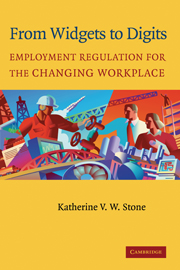Book contents
- Frontmatter
- Contents
- Preface
- Introduction
- PART I LABOR RELATIONS REGIMES OF THE PAST
- PART II THE DIGITAL WORKPLACE
- 4 The Changing Nature of Employment
- 5 The New Employment Relationship
- PART III IMPLICATIONS OF DIGITAL JOB STRUCTURES FOR LABOR AND EMPLOYMENT LAW
- PART IV SOCIAL JUSTICE IN THE DIGITAL ERA
- Summary and Conclusion
- Index
5 - The New Employment Relationship
Published online by Cambridge University Press: 14 January 2010
- Frontmatter
- Contents
- Preface
- Introduction
- PART I LABOR RELATIONS REGIMES OF THE PAST
- PART II THE DIGITAL WORKPLACE
- 4 The Changing Nature of Employment
- 5 The New Employment Relationship
- PART III IMPLICATIONS OF DIGITAL JOB STRUCTURES FOR LABOR AND EMPLOYMENT LAW
- PART IV SOCIAL JUSTICE IN THE DIGITAL ERA
- Summary and Conclusion
- Index
Summary
For the past ten years, labor relations professionals have been advocating and implementing changes in the organization of work. Chapter 4 reviewed empirical studies of the U.S. labor market that are indicative of a departure from internal labor market job structures. However, in order to understand these changes in the workplace, the empirical data must be supplemented with information about the expectations and experiences of employees and employers. Organizational psychologists and industrial sociologists have developed a vocabulary for describing these subjective aspects of the workplace and a methodology for studying them. At the same time, management consultants have devised innovative human resource practices and approaches that create and reflect these subjective understandings. This chapter summarizes these bodies of work in order to extrapolate the essential elements of the new employment relationship as it is described and designed by organizational theorists, industrial sociologists, management consultants, and corporate executives. Each of these professional groups, from its own distinct vantage point, is engaged in the creation of a new digital workplace. While some of their writings are aspirational rather than descriptive, they express the aspirations of those who are actively and self-consciously engaged in creating the new institutional structures of the workplace. These structures then shape the aspirations, opportunities, and expectations of today's workforce.
Imagining the New Workplace
Even the most routine types of work involve the exercise of discretion. Sometimes an employee has discretion over what to produce or how to produce it. Professionals, for example, have a great deal of discretion to select the tasks they perform, set their own pace of work, and even determine their own level of compensation.
- Type
- Chapter
- Information
- From Widgets to DigitsEmployment Regulation for the Changing Workplace, pp. 87 - 116Publisher: Cambridge University PressPrint publication year: 2004



